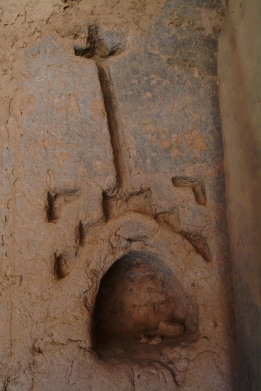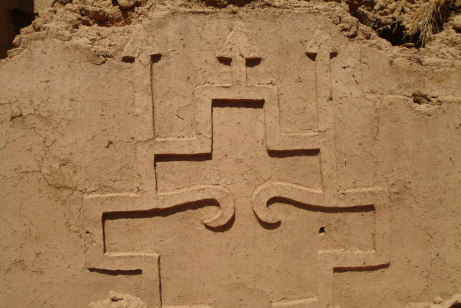Figurative imagery in Pre-Saharan Morocco after the 16th century
Ksour history is better known from the 16th century, when historians become able to cross-reference archaeological sources with literary sources. Ksar Abouam, for instance spans a plateau barely a km away from the ruined city of Sijilmassa. It replaced the antique city, which enabled it, for several centuries, to keep up the region's residual trading activities. Imperial Ksour may be recognized at their highly decorated towers, which embody the dynastic distinction of their occupants – often sultans' sons, who stood as direct representatives of power. It is the case for Ksar Lamaarka at er-Rteb that was built on Mowlay Ismail[1]'s orders at the beginning of the 18th century. The ksar was surrounded by defensive walls. It could only be accessed at one entry point, obviously intended to control incomers, notably foreigners who were invited to hand over their weaponry on the way. Each ksar formed an autonomous entity whilst fitting within a tribal system connected to one of the region's powerful networks. In those days, they were structured around the mosque: central, commanding, visually identifiable by its minaret, it stood as the ordaining element of the whole urban organism. The types of dwelling bear out the mark of ancient Rome. Built in rammed earth on several storeys with a patio, they are often decorated with large external geometric friezes in relief: dots, nets, crosses, ropes zigzag and wavy lines, chains, rhombi, squares, running as a rule in parallel bands. These abstract patterns are, according to G.H Bousquet, typical of Berber art. From the Christian heritage, nothing was left at the time, apart from a few words stolen from the Julian calendar and festivals such as carnival.



By then the Muslim religion regulated every aspect of everyday life bar for the Jewish population. Claiming to be descended from Muhammad, the shorfa[2] enjoyed considerable veneration. Their holy essence exempted them from warfare but they arbitrated disputes, be they between people or groups. Some villages or ksour were founded by a marabout who set up a zawiya[3] there. The locals vaunted the merits of this wali[4], scion of the Prophet's family, gage of water perennity, protector of the ksar, medicine man whose power to ensure the menfolk's good health and the womenfolk's fecundity was not in doubt. Accordingly a share of the crop was set aside for him. Such beliefs are entrenched in Oases societies. Many local springs get named after the holy man when the rains are late or the rivers dry; tribes journey to their zawiya to ask for a blessing. At his death the marabout's grave becomes a shrine visited by pilgrims. Annual moussems[5] bring thousands of followers and pilgrims seeking Baraka. The most significant Sufi mystical trends were present in the region.
The religious architecture of these regions offers a huge variety with singular traits that help identify a specific trend: an oratory with annexes, student pods set around a courtyard, a common room. The founding saint's funerary chamber is sometimes hard by the zawiya: a religious and funerary model in line with an Islamic architectural tradition longstanding in Morocco. The most interesting element in architectural and decorative terms is the cupola, which in most cases takes the shape of an overturned cup: the domes are not uniform but rarely do they become tile clad pyramidal roofs or flat wooden structures in the local style. Inside, cupolas are seen to rest on pendentives or squinches and are decorated in motives painted on plaster or lime coating, boasting complex geometric or floral motives. A room is set aside for the Saint's clothes and personal belongings: selham (burnous), sandals Zawiya papers - official documents and letters belonging to Zawiya members, family trees, royal decrees (dahirs). These lands are also home to the graves of Jewish marabouts whose names echo those of Old Testament prophets. Right up to the middle of the 20th century the hexagram is a constant feature in the iconography, the architecture, the numismatics and the seals of the Alaouite dynasty; and the Kasbahs of Southern Morocco often include in their patterns the six pointed star set in a crescent.
The igoudar-ighrem or collective granaries exist in other parts of Northern Africa where they are given a different name, for instance in Southern Tunisia, at Djebel Nafousa in Tripolitania (ksour), in the Aures (guelaa), the high Atlas (ighrem). They exhibit original features harping back to the preSaharian Moroccan architectural heritage. Traditionally considered hallowed places, agadir are associated to a range of practices towards the dispensation of divine providence, the barakah. Numerous internal devices such as jars or collection or money boxes lit by slit windows also bind them institutionally to local or regional holy men in receipt of (frequently daily) giving. The tribes also ensure the spiritual durability of these communal institutions by relying on the zawiyas, marabouts and more broadly the sanctity of the places and people. Thanks to these men's barakah the architectural heritage achieves a Horum[6] status whereby no evil can take place there. This moral prohibition secures immunity and universal respect for these institutions. Accordingly, each agadir sets a cell aside for the saint where the tribes leave gifts on their pilgrimage or visit to the saint's tomb after harvest. These tutelary figures are supposed to refresh the barakah smoothing the agricultural cycle and sheltering families from life's hazards. The granary and the Zawiya thus form the two terms of a complementary and vital system for these communities.






